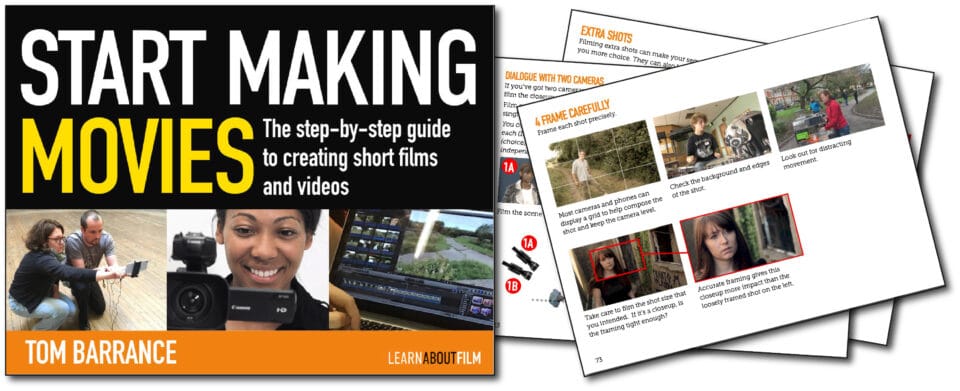Which of the Following Goes Against Principles of Continuity Editing Crossing the Line of Axis
- Follow these rules so that your shots will make sense together
- Keep all your camera positions on one side of an imaginary line
- Frame your shots carefully to show where people are looking
When you film a scene using separate shots, it's important that people understand where everything in the scene is. You can use the 180 degree rule, together withlooking spaceandeyeline match,to help them.
The 180 degree rule

Shot 1: Long shot
Imagine you're looking at a scene from the side. You can see the whole scene. If you look at one character, they are on the left hand side of the scene facing right. The other character is on the right side of the scene facing left.
You could just show your scene in long shot, but that would mean we couldn't see facial expressions, or details of what characters are doing, very well. It would also be quite boring because the camera position doesn't change.
Shot reverse shot

Shot 2: Mid shot

Shot 3: Closeup

Shot 4: Big closeup
It's much more interesting if you get closer and use separate shots, such as mid shots and closeups. It's best if the camera moves round so it's almost full on to the characters. This way we can see their expressions and identify with their emotions.
Shooting like this – first in one direction, then in the other direction – is called shot reverse shot.
The shots work together because the camera is still (just) on the same side of the characters as it was in the long shot. When the shots are edited together, we understand that they are looking at each other, because they are looking in the same direction as they were in Shot 1.
To make sure this works, we need to imagine a line between the two characters. This is called the axis of action.
Then we need to keep the camera on one side of that line. If you break the rule you have 'crossed the line'. In the diagram below, the camera needs to stay in the blue shaded area. (The rule also applies if the character is looking at a thing rather than another person.)
This is called the 180 degree rule because the camera can't move more than 180 degrees (half a circle) around the characters.

Crossing the line


Shot 4 with a medium closeup that has 'crossed the line'
If the camera swaps over to the other side for one of the shots, the pictures won't work together. Instead of facing each other, the characters now look as if they are facing in the same direction.
Eyeline match and looking space

When you join shots together using shot reverse shot, you need to be careful abouteyeline match. This means that the gaze of the character in one shot has to line up with the person or thing they're looking at in the next shot (as in the shot above).
If one character is higher than another, the taller character should be looking down and the smaller character should be looking up.

You should also frame the shots withlooking spaceornose room(more space in the direction they are looking).
Changing the line
Sometimes you need to change the line – if you have more than two characters, or you need to show the other side of the scene.
There are several ways to do this without the audience getting confused:
- Add a long shot/wide shot of the whole scene
- Insert a cutaway or B-roll shot (a shot of something that's not part of the main action)
- Add a closeup/insert of a detail
- Include a shot where the camera itself tracks (moves sideways) or moves in anarc across the line
Interviews
The 180 degree rule works for interviews as well, cutting between interviewer and interviewee. But you can get problems with eyeline if you're filming up close and wide angle: the interviewee may seem to be looking well off to one side, which seems evasive. You can reduce this effect by keeping both camera positions really close to the axis, and moving back (using a standard or medium telephoto lens setting) to reduce the angle between the interviewee's eyeline and the camera.
Moving subjects
If a character is moving, the axis is the direction they are moving. If you cross the line they'll look as if they are going in a different direction.
Tip: the main characters in films usually move from left to right. Bad guys, or people who are going to obstruct the main character, go right to left.
The 180 degree rule is part of the continuity system, the standard way of planning, shooting and editing a movie so it makes sense.Learn more about the continuity system.
My new pack EditClass is a hands-on way to learn about the 180 degree rule and other aspects of the continuity system. It's a complete short movie for you to edit, with a choice of over 90 clips including movement, action, dialogue and B-roll.
The package includes a PowerPoint introduction to the continuity system, and a user guide covering editing principles, workflow and tips, and intermediate editing exercises. It also includes guides to essential techniques in Adobe Premiere, Final Cut Pro, and iMovie (Mac and iPad/iPhone versions). Learn more…
Education licence $79Buy now (secure instant download)
Source: https://www.learnaboutfilm.com/film-language/sequence/180-degree-rule/





0 Response to "Which of the Following Goes Against Principles of Continuity Editing Crossing the Line of Axis"
Post a Comment